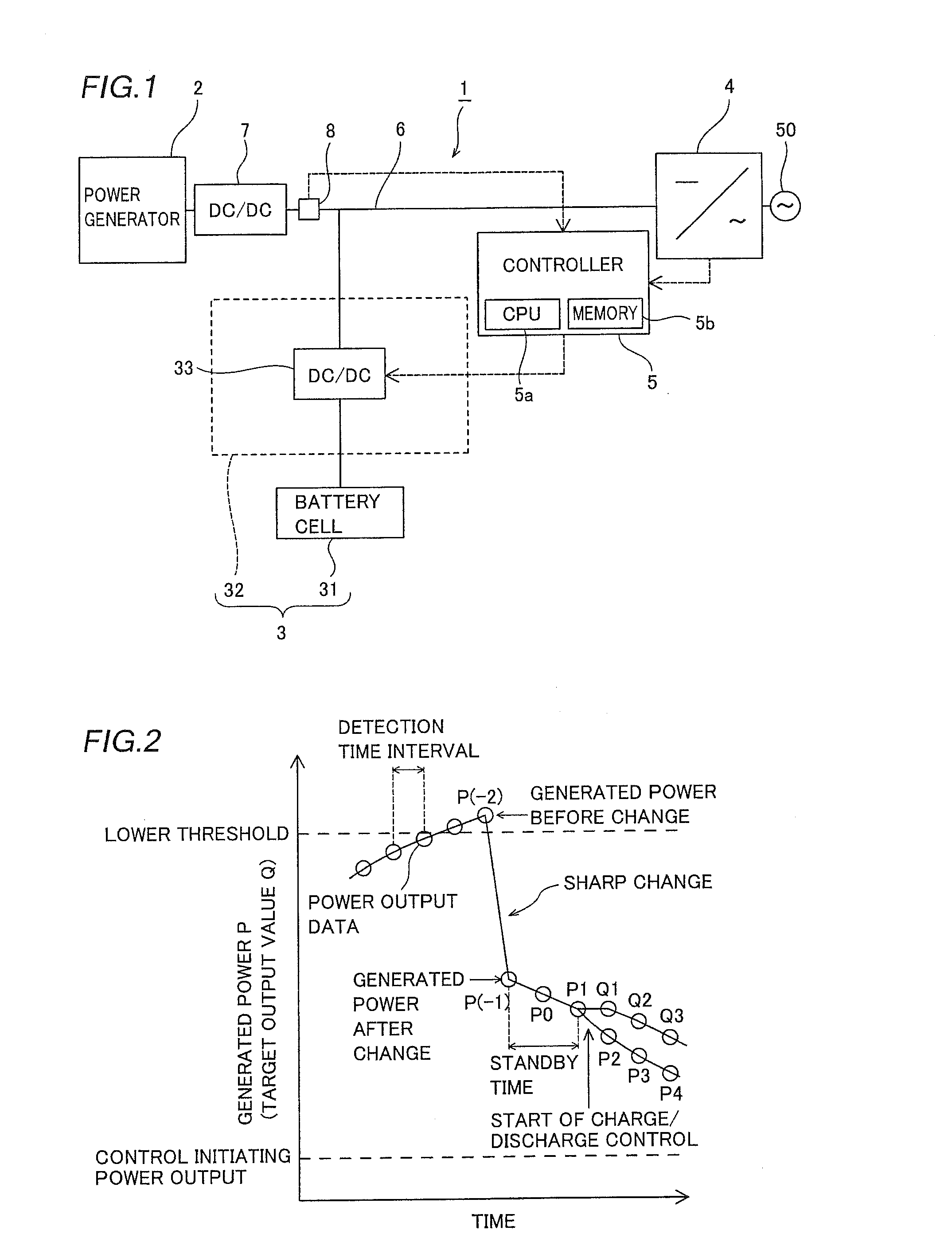Charge/Discharge Control Device and Power Generation System
- Summary
- Abstract
- Description
- Claims
- Application Information
AI Technical Summary
Benefits of technology
Problems solved by technology
Method used
Image
Examples
first embodiment
[0050]First, the structure of a power generation system (photovoltaic power generation system 1) according to a first embodiment of the present invention is described with reference to FIGS. 1 to 7.
[0051]The photovoltaic power generation system 1 according to the first embodiment of the present invention includes a power generator 2 including a solar cell generating power with sunlight, a battery 3 capable of storing the power generated by the power generator 2, a power output unit 4 connected to a power grid 50, including an inverter outputting the power generated by the power generator 2 and the power stored in the battery 3 to the power grid 50, and a controller 5 controlling charge and discharge of the battery 3. The controller 5 is an example of the “charge / discharge control device” in the present invention.
[0052]A DC-DC converter 7 is serially connected to a DC-side bus 6 connecting the power generator 2 and the power output unit 4. The DC-DC converter 7 has a function of conv...
second embodiment
[0120]Next, a power generation system (photovoltaic power generation system 100) according to a second embodiment of the present invention is described with reference to FIG. 17.
[0121]As shown in FIG. 17, the photovoltaic power generation system 100 includes three power generators 2a, 2b, and 2c each including a solar cell generating power with sunlight, a battery 3, a power output unit 4, and a controller 15. The total power generated by the power generators 2a, 2b, and 2c is preferably set to be not more than generated power capable of being processed by the power output unit 4. The controller 15 is an example of the “charge / discharge control device” in the present invention.
[0122]The three power generators 2a, 2b, and 2c are connected in parallel to the power output unit 4. DC-DC converters 7a, 7b, and 7c each having an MPPT control function are provided on the power generators 2a, 2b, and 2c, respectively. The DC-DC converters 7a, 7b, and 7c each have a function of converting th...
third embodiment
[0127]Next, a power generation system (photovoltaic power generation system 200) according to a third embodiment of the present invention is described with reference to FIG. 18. In this third embodiment, an example of controlling charge / discharge of a battery cell 31 in response to the operation state of a load 210 in addition to performing charge / discharge control according to the aforementioned first embodiment is described.
[0128]As shown in FIG. 18, the photovoltaic power generation system 200 includes a power generator 2, a battery 3, a power output unit 4, a controller 201, a DC-DC converter 7, and a power output detection unit 8. A distribution board 202 is provided on an AC-side bus 9 between the power output unit 4 and a power grid 50. Furthermore, three loads 210, 220, and 230 are connected to the AC-side bus 9 through the distribution board 202. The load 210 is frequently employed in time (about 2 minutes to about 20 minutes) of the lower limit period T2 to the upper limit...
PUM
 Login to View More
Login to View More Abstract
Description
Claims
Application Information
 Login to View More
Login to View More - R&D
- Intellectual Property
- Life Sciences
- Materials
- Tech Scout
- Unparalleled Data Quality
- Higher Quality Content
- 60% Fewer Hallucinations
Browse by: Latest US Patents, China's latest patents, Technical Efficacy Thesaurus, Application Domain, Technology Topic, Popular Technical Reports.
© 2025 PatSnap. All rights reserved.Legal|Privacy policy|Modern Slavery Act Transparency Statement|Sitemap|About US| Contact US: help@patsnap.com



